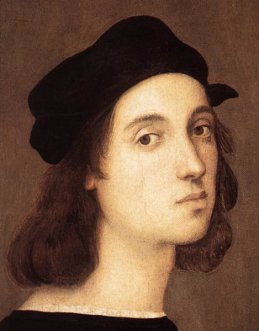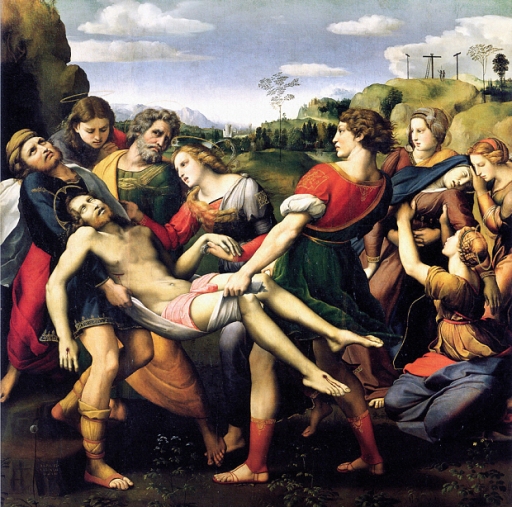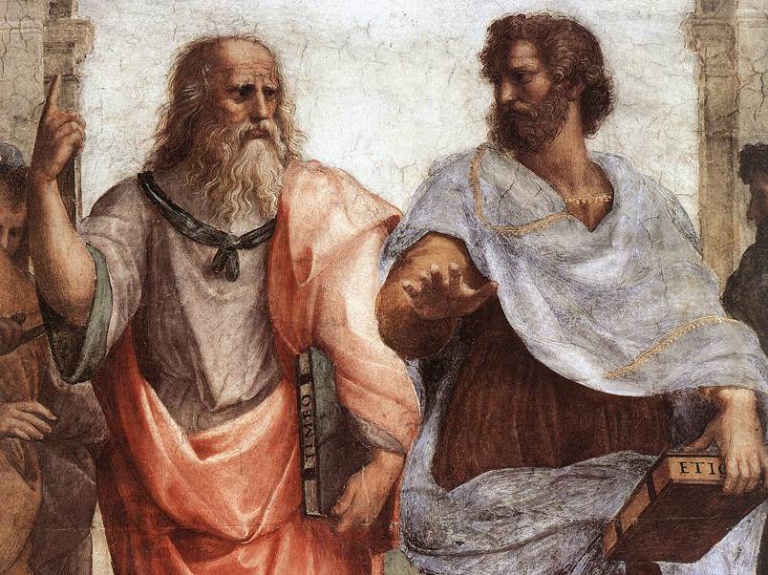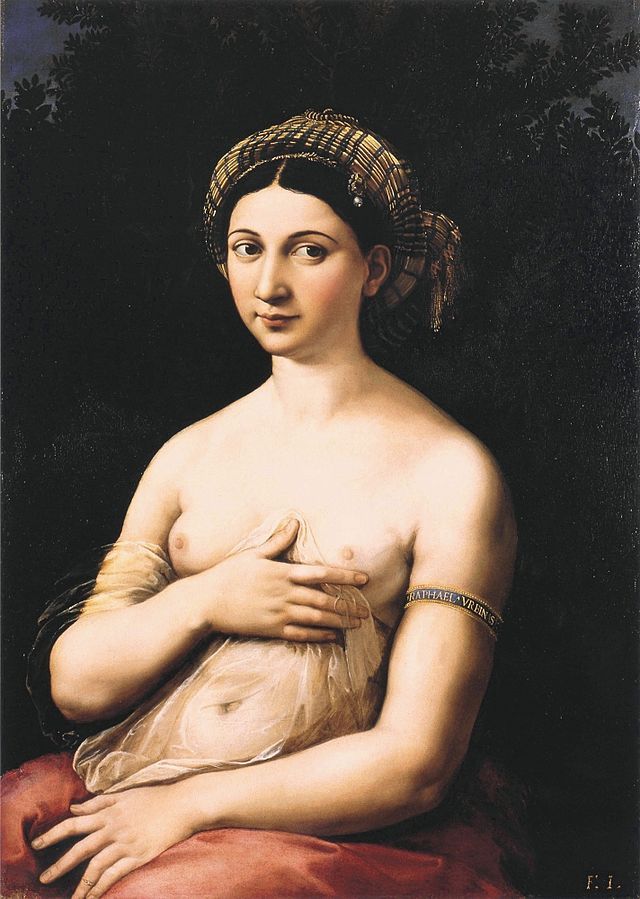
Raffaello Sanzio De Urbino , popularly known as Raphael, was one of the artistic giants of the traditional trinity of masters from the Italian High Renaissance. Celebrated to be an artist of groundbreaking and revolutionary perspective, he was known for his lucidity, spatial distribution and clarity of form, experimenting with the possibilities of human anatomy in his expression, using variations in the colour palette to achieve depth and solidity, as well as breaking away from the usual norms of artistic allegory so prevalent in his times to pave a way for dynamic compositions that have immortalised his paintings. Being remarkably adaptable and progressive in his style, he was capable of entering new environment ripe with characteristically distinct art, grasping the essence of the pictorial stimuli, and seamlessly incorporating this experience to his own works with uniqueness. No Renaissance artist so successfully, and repeatedly, invented and reinvented himself as did Raphael.
According to Vasari’s Lives of Artists, Raphael first tried painting in his father, Giovani Santi’s workshop, who was a court poet and mediocre painter, in Umbria. Upon realising the potential of the young child, he sent his son to be an understudy to Pietro Perugino, a notable painter in the state of Urbino at that time. Raphael was so adept at learning the skills that his master had to offer, that within a few years, it was almost impossible to tell the difference between their works.
Constantly striving for improvement, he then sought out newer frontiers, eventually reaching Florence, where the new High Renaissance style, which would eventually be set forth in the works of Da Vinci, Michelangelo, Fra Bartolommeo, and Raphael himself, was still in the process of definition. The sophistication with which Florentine artists handled narrative and the expression of emotions greatly impressed the young Umbrian, and he had much to observe and learn. Hence, Raphael had set himself deliberately to learn, from Michelangelo, the expressive possibilities of the human anatomy, and from Da Vinci, his lighting techniques and sfumato. But Da Vinci and Michelangelo were both painters of dark intensity and excitement, from which Raphael differed, wishing to develop a calmer and more extroverted form that would serve as a universally accessible style. However, Vasari specifically stated that Raphael, inspired by Michelangelo’s rendering of the human form, devoted himself to a detailed study of figures, and “the concatenation of the bones, nerves and veins”.
Factually, Both Da Vinci and Michelangelo took part in dissections in order to gain perspective of the human anatomy, which was crucial in order to fashion limbs in accordance with the actions and positions that each figure would assume, especially those represented in nude. Although no anatomical sketches made by Raphael survive that may suggest him undertaking such a method of research, he was still known to make drawn studies of fighting nude men, and hence, was adept at creating realistic figures with believable body language. For example, the structural similiarity in the Entombment of Christ (Desposition) and Michelangelo’s Pieta is uncanny, to Raphael’s credit. The right hand of Christ in both these works of art is exactly similar, discounting minute variations that may be attributed to the different mediums in which they are depicted. The dynamic contours of dead Christ’s hand in the painting is directly quoted from the celebrated marble sculpture, several modern art historians have noted, as it is quite visibly evident to the contemporary art viewer. Moreover, what is interesting to note is that this painting is one of the few that bore Raphael’s signature, to which this seemingly emulated hand of Christ points to directly recalling the hand of the painter who created it. This also suggests that the hand carved by the famous sculptor is indicating the painter out to his viewers- Raphael’s attempt to perhaps undermine Michelangelo. Certainly, it is a deliberate manifestation of the rivalry that existed between these great masters.

However, this is not the first instance of ingenious signature placement by Raphael, who previously had inscribed his name in the Sposalizio (Betrothal of the Virgin). The inscription is carved in the cornice of the Temple, the name and date incised on both sides of the painting’s central axis, immediately above the vanishing point. The domed structure depicted in the painting was a central plan of Pietro Perugino, and upon signing his name on his master’s building, Raphael claimed it as his own. One of Raphael’s most ostentatious signatures, it vaunts his achievement in surpassing his predecessor.

Paolo Giovio, author of Life of Raphael(1530), the first biography of Raphael, marks the distinct stylistic changes that occurred in his paintings since he became engaged in Florence. The composition of his paintings became more mature and skilful, employing colouring that was the model of naturalism and of decorum. Giovio praised Raphael’s colouring for “mitigating the harshness of too vivid colour by using mixed colours in oil”. Raphael avoided pure, unmixed colours, in contrast to contemporaries, such as Michelangelo, who were prominent at that time. Raphael approached colouring by “toning down colour saturation”, and “limiting colour values” to create a greater sense of unity in the overall distribution of colours across the surface of the picture. Shunning the colour style of his Umbrian past, Raphael followed Da Vinci in selecting tones that do not “compete with each other for attention”, yet ensuring that they retain enough beauty of hue to blend together in harmony. Michelangelo used a method to create unity with pure colours by avoiding modelling in light and dark. Rather, he juxtaposed colours of different wavelengths in the draperies. The author agrees with Raphael’s view of not merely celebrating each colour for its intrinsic beauty as a pigment, but rather investing in achieving better perspective of their interplay with each other in the entire frame of the painting. Being well versed in classical literary theory, and skilfully attuned to the subtleties of tone in paintings, Raphael’s colouring was an example of balance between dull subdued tones, and extremes of pompous colours, consisting of subtle gradations in the richness and vibrancy of hues. Vasari describes Raphael’s sense of colour as a characteristic of “approaching Leonardo in grace”. With an incomparable ability to depict various textures, folds and draperies, and with the shrewdness to pair it with his dynamic figures, Raphael had delved into realism quite effectively. He related colours of the draperies and garments to the flesh tones of his semi nudes such that they retain the natural aspects of their postures, which was often a difficult feat to achieve for painters of the human form. His paintings were characterised by clever blending of light and shadow, which play a key role in evoking a sense of roundness and distance in visual medium. Thus, with the soft execution of the blurred edges, Rafael is successful in creating the illusion of “natural” light. The Lombard writer Giovanni Paolo Lomazzo (i 584,1590), stated that Raphael created a convincing distribution of light that made him an exemplar of naturalistic colour palettes that gained importance much after the painter had died.

Located in the Stanza della Segnatura in the Vatican, Raphael’s School of Athens has long been admired as a monument in the artistic flamboyance of the Italian high renaissance, standing out as an amalgamation of all the virtues of Raphael’s artistic style. It is a fresco painting done on sections of fresh plaster on one of the four walls of the room which is now known as Stanze di Raffaelo, which was chosen to house the papal library in the Apostolic Palace. Being a library, this room was designed to be dedicated to the high intellectual pursuit, which maybe said to embrace the human culture in some for or the other. Each wall in the room depicts distinct branches of knowledge- Theology, Poetry, Philosophy and Juripudence, the themes of which are identified by the separate tondos on top of each fresco. Raphael’s masterpiece, The school of Athens is presented under the tondo of philosophy. Traditionally, Philosophy is shown allegorically by artists as a female figure, which is a direct reference to the passage in The Consolation of Philosophy, where Dame Philosophy visits Boethius as a majestic woman holding a sceptre and several books, robed in clothes with grand embroideries of the Greek alphabets. Moreover, in a far simpler explanation of the feminine form of Philosophy stands the grammatical fact that in both Latin and Greek, the abstract noun is of feminine gender, as a result of which all the allegorical personifications assume the female sex. Adhering to these norms, Raphael’s tondo professing the theme of Philosophy is that of a majestic woman seated on a throne, holding two books bearing the titles Moralis and Na[tura]lis, and she is flanked by two heroic children who stand bearing the heavy labels “Cognitio” and “Causarum”.

Below it stands the magnificent scene of the celebrated Greek philosophers in action, indulging in the practice of some of the seven liberal arts. The portraits of the fifty eight individuals have been fashioned after the faces from classical statues, or have been modelled upon his contemporaries. Although identifying these figures is still an ongoing scholarly game, they are not in random arrangement; their distribution in the grand place has been well planned out by the painter, and an analysis of its composition sheds light on the possible motives that Raphael might have had in embodying philosophy by means of the philosophers.

The School of Athens is a picture which is balanced out in terms of symmetry which originates from the centre of the frame, where stand the pair of parallel figures of Aristotle and Plato, readily recognisable by the bounded copies of books that they each carry in their hands, bearing prominent titles. It is here that the picture is divided into two, the realists on the right with Aristotle , and the idealists on the left with Plato. Each of the pair gestures conspicuously with his right hand, while looking toward each other, forming the basis of the only dialogue present in the painting where two speakers converse with and look at only each other. The complementary nature and parallelism of this central pair is deepened by the surrounding figures present in two rows of straight lines on the left and right who are listening to the central dialogue with passion and intensity, thereby programming the reaction of the painting’s viewers as well. Evidently, Plato and Aristotle are being assumed as the two complementary alternatives that describe the essence of all Greek philosophy in their harmonious oppositions: physics versus moral philosophy, the Timeo versus the Etica, the finger pointing heavenwards versus the open outstretched hand, or as the titles of the books in the tondo above suggest, Naturalis and Moralis. The axial symmetry is continued on both sides in a series of characters that are distributed throughout the painting in more or less uniform spatial distribution. If this central pair with its audience is considered a single group in the painting, then it may be said that the painting is divided into three clusters of people. To the left is the group containing Pythagorus , who in their own right is engrossed in themselves, unaware of the narrative of the central figures. This is balanced out by the group on the right containing Euclid with his compass, and the astronomers who seem to be engaging in intellectual discourse, thereby most oblivious to the proceeding at the centre.
Another compositional aspect of Raphael’s work is his tendency to work from left to right. To quote Springer’s Raffael’s Schule von Athen, “ In Pythagoras’s group, there are four young males of increasing age arranged from left to right (the baby at the extreme left, the boy looking at us from behind the Arab, the youth holding the tablet, and the beautiful young man in white) and three stone blocks of increasing size along the floor from left to right (under Pythagoras’s foot, under the man standing and looking at him while pointing to an open book, and beside the meditative figure seated near the center). So, too, the only figures who can be securely named appear in chronological order from left to right: Pythagoras, Socrates, Plato, Aristotle and Diogenes, Ptolemy, and Raphael. This left-to-right directionality makes it all the more tempting to read the fresco.”
Moreover, much has been discussed and debated about Raphael’s choice of architecture and the overall composition of the School of Athens, and it has been suggested that the only possible inspiration is Lorenzo Ghiberti’s depiction of the Queen of Sheba and Solomon on the bottom-right panel of the Porta del Paradiso , whose uncanny similarity to Raphael’s masterpiece has often been noted. However the only point of difference is that in Ghiberti’s work, the central focus is held unfalteringly for all the gaze and attention of the entire audience is directed to the pair at the middle, which is not true in case of The School of Athens, where only the immediate listeners may be entranced by the central characters but the groups on the extreme left and right seem untouched by the activity in the centre, and maintain their own autonomy.

The School of Athens is one of Raphael’s signed works, being also an example of one of the most conspicuous signatures to exist in art. Adapting from the styles of Perugino, who often added inscriptions on the hems and borders of clothes, disguised along with meaningless squiggles and gibberish to camouflage as a pattern, Raphael’s signature exists on Euclid’s collar so ingenuously blended with the embroidery of the clothing that it is easy to miss. Amidst the golden embroidery of Euclid’s collar, the letters “RVSM” exist, denoting “Raphael Vrbinas Sua Manu”.

Euclid is one of the more notable figures in the fresco being a celebrated mathematician, and more so, because a series of scholars have tried to explain the diagram that he is stooping over with a compass in hand, in The School of Athens. And although various theories exist, venturing it to be a theorem on hexagrams as Fichtner has suggested, or alternatively, the diagram may be symbolic in architecture, as Valtieri has proposed, it may just be something Raphael imagined without any mathematical allusion. Just as the Madonnas are not a visual doctrine on how to hold babies, but a celebration of childish innocence and motherly tenderness, it may be safe to say that the diagram is irrelevant scientifically but is only an accessory to the portrait of the mathematician whose collar Raphael had signed instead of his own self portrait, a remarkable instance in the history of art, and may be considered as an act of expressing devotion and respect.
A purposefully equivocal amalgam of dominance and devotion characterizes Raphael’s last signature engraved on his only signed female portrait, La Fornanarina. Inscribed on the arm band of the semi nude portrait of the beautiful woman, is “RAPAHEL VRBINAS”. The audacity of this placement sets it apart from the other signatures, recalling instead the ostentatious inscription on the temple facade in Sposalizio, which declared his superiority and independence from his early master, Perugino. The signature serves not as a simple declaration of the maker’s name, but goes forth to suggest personal and professional significance, due to which the identity of the lady depicted in La Fornanarina has interested so many scholars. The dignified direction of her gaze that avoids eye contact with the beholder, and Raphael’s name on her arm, are elements that shield her despite her nudity. Raphael allows the viewer to look but defends her by naming her as his own possession.

In a letter to his friend, Baldassare Castiglione, Raphael wrote that “ in order to paint a beautiful woman, I would have to see several beautiful women… but because there are so few, I make use of a certain idea that comes to my mind. Whether it carries any excellence of art, I do not know, but I work hard to achieve it.” For this reason, many of Raphael’s Madonnas and other females have similar facial features, for they are simply a distillation of the various women he had come across, and had reproduced formulaically. However, La Fornarina is different and thereby, more special because Raphael had memorialized the awkward irregularities of her visage, and had commemorated her as an individual. His liberality to allow “his” woman individuality that his contemporaries only accorded to men ameliorates the blunt implications of dominance and ownership that his signature brought forth.
There was prevalent vulgar idea that promoted the notion that Raphael was a man of dissipated and vicious habits and as a result, died a victim to his excesses. But since no tangible proof exists that might support this claim, one should rather focus on the self aware nature of the artist, who had the sensibility to envision and depict the individual spirit of a woman in the 16th century. He not only redefined popular notions of beauty but also influenced the art of the high renaissance deeply. Perhaps he is not considered as great as Leonardo da Vinci or Michelangelo for they have a far more extensive body of work, but even in this one must take into account the unfortunately short life that he lived, and excite the mind over the imagined possibilities of artwork that would exist if Raphael had survived as long as the other two masters.

a wonderful exposition and detail especially in The School OF Athens narrative. I agree His way of departure is unimportant as compared to his immense sensibility to the intimate woman form or the vastness he embraces effortlessly in his larger storytelling..
LikeLike